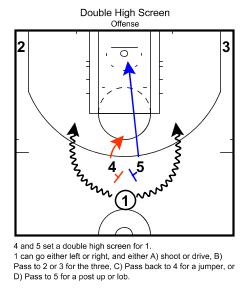Two years ago in the 2015 first round playoff series between the Los Angeles Clippers and San Antonio Spurs, there was one set I had written about on ProjectSpurs.com that was giving the Spurs’ defense problems throughout the series that the Clippers were running – their double-high screen.
The Spurs ended up losing that series in an epic seven game series, and fast forward two years later to Saturday night in the AT&T Center, and there were the Clippers still running that double-high screen set with effectiveness on most possessions it was used.
So, how can such a simple set be so effective in today’s NBA? It’s all about how the defense has to pick their poison when guarding this type of possession, as will be broken down below.
If run effectively, this play can generate looks for each of the five players on offense in the following ways:
1) The point guard, usually Chris Paul or Raymond Felton has multiple options. First, they get to choose by reading the defense which side they’d like to drive – left or right. They can either shoot a mid-range jumper, drive toward the rim for a layup or kick out, or throw a lob to 5, the roll man, usually DeAndre Jordan, or, pass back to 4, usually Blake Griffin for the jumper or a mismatch with a guard.
2) The shooting guard, usually J.J. Redick or Austin Rivers, can wait for an open three to open in the corner, or catch the ball while his defender is closing out and either settle for a lob to the roll man (5), a layup, or mid-range jumper.
3) The same element that (2) gets is what three gets too, which is usually Luc Mbah a Moute or Jamal Crawford.
4) The power forward, usually Griffin or Marreese Speights, can either shoot the open mid-range or 3-point jumper, find himself with a mismatch and either post-up or drive, or lob to (5) or throw a pass to an open shooter in the corner.
5) The center, usually Jordan or Speights, can roll to the rim and try to wait for an alley-oop dunk, get better position for a post-up, or if he catches the ball deep in the paint, he too can kick out to an open shooter.
In the video below, I’ve shown several clips of the Clippers running this play early in the season and the many options it generates for them on offense. What’s even more effective about this play is also how you don’t always have to run it from the top, as it’s effective too from either the right wing or left wing area as well.
[protected-iframe id=”6245bc357bb08800d31df97647bce76c-114320562-25928832″ info=”https://streamable.com/e/f6v2″ width=”560″ height=”278″ frameborder=”0″ scrolling=”no”]So why is the double high screen so troublesome for defenses to guard?
The main issue defenses have in guarding this set is that it involves their two big men each time. Most bigs don’t want to allow points in the paint, so as soon as the Clippers use the set, both bigs are in miscommunication because they’re not 100% sure which way Paul will go, so, their natural instinct is to both go toward the rim to stop a Paul layup, or Jordan dunk. This, most times, leaves Griffin wide open by himself at the top of the arc. If at any point penetration is broken, the two defenders guarding the shooters in the corner have to leave their assignments and help near the rim, which can leave someone like Redick, a deadly three-point shooter, open for a look in the corner. Even if the bigs contain Jordan and the guard has to stay on Griffin, Paul gets his preferred matchup with a big to attack 1-on-1.
It’s early in the NBA season and as the playoffs approach down the road, opposing coaches will tinker with different defensive formations and player personnel to try to find a way to limit the effectiveness of this dangerous double high screen the Clippers have been using.
Add The Sports Daily to your Google News Feed!







